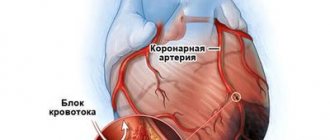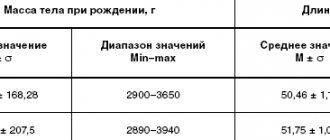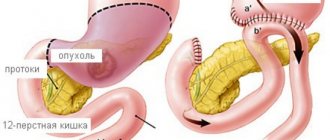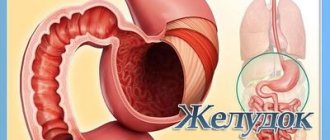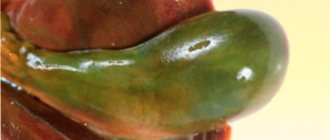Hepatomegaly in a child is not an independent disease, but a morphological sign indicating an increase in the size of the liver. It is often diagnosed, but the symptom is not always dangerous.
The condition can be pathological - associated with any disease of the liver or other internal organs, and physiological.
The causes of hepatomegaly in children and the mechanism of development, types, diagnostic measures and therapeutic strategy - we will consider in detail.
Types of hepatomegaly in childhood
If a child’s liver protrudes more than 1 cm beyond the right lower rib, then they speak of an increase in the size of the internal organ, which means hepatomegaly.
The condition can be physiological - it does not pose a danger to the health and life of the child, and pathological - it is associated with some kind of disease of the liver itself or other internal organs.
Types of hepatomegaly in infants and older children:
| Diagnosis | Description |
| The child has moderate hepatomegaly | The increase in liver size is insignificant. When there is no progress, therapy is not prescribed; medical observation is sufficient. |
| The baby has a severe form of hepatomegaly | This diagnosis is made if a deviation of up to 10 cm is detected. Additional research must be carried out to determine the original source. |
| Diffuse form of hepatomegaly | The liver exceeds the norm by 10 cm. The situation is critical and immediate medical attention is required. |
The medical classification separately distinguishes partial hepatomegaly - this is an uneven increase in the lobes of the liver. This type is typical for cystic or tumor neoplasms.
Normal liver size
Each internal organ has its own parameters - size, volume, shape, weight. When they change, it is necessary to look for the cause, since deviations indicate pathologies.
Depending on a person’s age, normal liver parameters differ:
- The size of the child’s right lobe is up to 60 mm. Measure from the bottom to the top edge of the organ. For the left lobe, the normal value is 40 mm.
- By the age of 15, the right lobe of the gland increases to 100 mm, and the left to 55 mm.
- By the age of 18, the right lobe is already 120 mm, and the left is 60 mm.
The given dimensions can be considered reference values. Hepatomegaly in an infant is diagnosed if, at the appropriate age, the gland parameters are not equal to the normal liver parameters.
Symptoms of hepatomegaly in children
Hepatomegaly itself is manifested only by an enlarged liver. The main symptoms relate to the diseases that caused this syndrome.
Thus, hepatitis is characterized by jaundice and characteristic changes in blood tests (increased levels of bilirubin, AST, ALT, alkaline phosphatase and gamma-glutamyl transpeptidase).
Jaundice is also characteristic of hemolytic anemia, but in the blood there will be a decrease in hemoglobin, the number of red blood cells, and in some types of anemia, a change in the shape of red blood cells.
Heart defects are manifested by weakness, bluish skin, and a characteristic murmur upon auscultation (listening) of the heart. Budd-Chiari disease is characterized by ascites. Often hepatomegaly is not accompanied by severe symptoms, which complicates the diagnosis.
Etiology of liver enlargement in a child
Hepatomegaly in newborns and older children is diagnosed by ultrasound. The study shows the structure of the organ, size, echogenicity and other parameters that allow us to draw a conclusion about the condition of the liver.
Physiological enlargement of the liver is quite common in preschool children. Over time, the parameters normalize on their own; therapy is not required. We can say that the body itself “catches up” with the rapidly growing gland.
When a child is over 7 years of age, pathological hepatomegaly is diagnosed, you need to look for the reasons:
- Inflammatory processes in the hepatobiliary system.
- Infectious pathologies.
- Parasitic diseases.
- Liver cyst or abscess.
- Intoxication of various etiologies (toxic substances, medications, etc.).
- Violation of metabolic processes.
- Impaired flow of bile or blood from the gland due to blockage of the biliary tract.
- Fibrosis, biliary cirrhosis - the immune system attacks liver cells.
- Benign and malignant neoplasms.
In a newborn child, hepatomegaly may be a consequence of illnesses suffered by a pregnant woman.
Specific signs of the disease in men and women
Doctors identify signs of liver disease in women and men. While the overall picture is similar, specific symptoms appear due to disruption of the production and processing of sex hormones.
Signs of liver disease in men appear due to an excess of androgens in the body. The testicles gradually atrophy, gynecomastia develops, and only one of the glands may be enlarged, it becomes painful, and the skin of the nipple is pigmented. External signs of liver disease in men are often accompanied by impotence and infertility. With the development of liver cirrhosis in men, hair falls out in the abdominal area - the stomach “goes bald”.
In women, due to excess estrogen, atrophy of the uterus and mammary glands begins, and the menstrual cycle is disrupted.
How does hepatomegaly manifest?
An increase in the size of the liver in a child several months old or 2-3 years old is accompanied by certain signs.
Common signs are changes in skin color and the appearance of capillary stars on the surface of the skin.
Children lose their appetite, refuse food, become irritable, capricious and whiny.
Disturbances in the digestive system are detected - diarrhea and constipation alternate, nausea, vomiting, and increased gas formation are observed.
Symptoms
What symptoms are accompanied by hepatomegaly in children directly depend on the cause that provoked it. You can tell that your baby has an enlarged liver by the following signs:
- constant fatigue;
- the baby stops reacting cheerfully to what surrounds him;
- abnormal blood clotting;
- loss of appetite or its complete absence;
- yellowness of the skin;
- ascites;
- often hepatomegaly is accompanied by intestinal disorders - diarrhea, constipation, etc.;
- a characteristic sign is the formation of capillary “stars” on the surface of the child’s abdomen;
- the baby may complain that he has a bitter taste in his mouth;
- pain in the right side of the abdomen.
When these signs are expressed, it is important to visit a qualified doctor as soon as possible so that he can find out and eliminate the cause of this condition in the child.
Diagnosis and treatment methods for hepatomegaly
To begin treatment, you need to establish the exact cause of the disease. Differential diagnosis is carried out, since hepatomegaly is characteristic of various liver diseases.
Initially, an external examination is carried out, the abdominal area is palpated. Blood tests are prescribed - CBC, biochemical screening, blood clotting test. At the same time, an ultrasound scan of the liver and hepatobiliary tract is performed. If necessary, a test to determine helminths is prescribed.
Sometimes hepatomegaly is a consequence of malignant neoplasms. If you suspect a tumor, you need to undergo tests that identify cancer markers.
Therapeutic strategy
First of all, a diet is prescribed. All fatty, salty, hot and spicy foods and sweets should be excluded from the child’s diet. Products are allowed according to table No. 5.
The treatment strategy is directly determined by the root cause of the disease. So, for hepatitis that has led to liver damage, antiviral treatment is required. If the etiology is due to infection, broad-spectrum antibacterial drugs are prescribed.
The regimen may include the following medications:
- Hepatoprotectors.
- Choleretic medications.
- Enzyme preparations.
- Vitamin and mineral complexes.
- Antihistamines.
- Anti-inflammatory medications.
According to reviews, folk remedies are effective for moderate hepatomegaly - a decoction based on oats, birch and lingonberry leaves. You need to mix a glass of oats, 3 tablespoons of leaves, pour 1000 ml of hot water. Leave for several hours. Give the child 50 ml 4-5 times a day, regardless of meals.
Diagnostic measures
When contacting a medical institution, the first thing a specialist will do is examine the baby and palpate the area of the right hypochondrium. In addition, he assesses the condition of the skin. To assess how severely the liver is affected, some laboratory tests are ordered, in particular the following:
- blood biochemistry;
- liver tests;
- coagulogram;
- immunogram;
- analysis for tumor markers;
- tests to detect parasites in the body.
Liver tests in children
In addition, instrumental diagnostics are also carried out:
- radiography;
- Ultrasound;
- CT scan.
The best medicines for hepatomegaly
Since the symptom is provoked by liver diseases, the main drug treatment is based on the use of powerful hepatoprotectors. They are supported by medications with an antioxidant effect, as well as drugs that stimulate blood flow in the tissues of the affected organ. Sometimes doctors add medications with alpha lipoic acid, which allows glycogen to accumulate in cells. It is worth highlighting the five most popular drugs from all categories:
| Name of the drug | Main active ingredient | Manufacturer |
| Alfa-Lipon | Alpha-lipoic acid | Ukraine |
| Thioctacid | Thioctic acid | Germany |
| Heptral | Ademetionine | Italy |
| Urosan | Ursodeoxycholic acid | Czech Republic |
| Legalon | Milk thistle fruit extract (Silybi mariani fructuum extract) | Germany |
To treat hepatomegaly, you need to consult a doctor. Self-selected treatment can aggravate symptoms and, worse, acute pain. This is due to the fact that a person cannot himself determine the causes of liver growth. Therefore, if the necessary research has not been carried out, you need to be persistent. All the same, the most effective medications are only available with a prescription from a physician, pediatrician or gastroenterologist.
Alpha Lipon solution and tablets
Alpha Lipon is prescribed for neuropathies of various natures, chronic hepatitis, and cirrhosis of the liver. It helps with poisoning from heavy metals, mushrooms, salts or chemicals. Sometimes this multifunctional drug is prescribed as part of the prevention and treatment of atherosclerosis. You need to remember the basic characteristics of Alpha Lipon:
- sold in the form of white tablets with a digestible coating or solution for injection;
- the initial daily dose is 600-900 milligrams, but it can be adjusted by a doctor;
- the price for one package starts from 905 Russian rubles.
The manufacturer warns that the patient may develop an allergic reaction or urticaria. Less common symptoms include hypoglycemia, dizziness, or increased sweating. Usually, all these consequences of taking Alpha Lipon go away without medical intervention.
Occasionally, after an injection, double vision and heaviness in the head occur.
The drug is strictly prohibited for newborns or people with hypersensitivity to the active substance or side components. It can be used in the treatment of pregnant women, but only if the risk to the fetus is less than the expected therapeutic effect.
Thioctacid tablets
Thioctacid is prescribed for diabetic and alcoholic polyneuropathy. The fact is that the active substance in this product neutralizes toxic compounds that enter the body. Thanks to this, Thioctacid is suitable for stabilizing the size of the liver. You should know about the features of the drug:
- Available in the form of yellow-green film-coated tablets of 600 milligrams;
- prescribed for oral administration at 600 milligrams per day;
- the product will cost 1604-3025 rubles, but you can find cheaper offers online and in social pharmacies.
There is no data on the use of the drug in pregnant women, lactating women, children and adolescents. Therefore, giving it to these groups of patients is dangerous, to say the least. Thioctacid is not prescribed if you are intolerant to thioctic acid. If the dosage is incorrect or the body is generally weak, the patient may experience the following side effects: nausea, dizziness, itching and urticaria. In the worst case, anaphylactic shock occurs.
Heptral in solution and tablets
The range of applications of Heptral is wide. Most often it is prescribed for fatty liver, chronic hepatitis, toxic liver lesions of various etiologies, cholangitis and cirrhosis. The medicine helps with symptoms of depression or in the treatment of intrahepatic cholestasis in pregnancy. The features of this drug are:
- there is a lyophilisate for preparing a solution and tablets of 400 and 500 milligrams;
- the dose is set individually, taking into account the age and general condition of the body;
- One package of such a hepatoprotector costs 1530-2149 Russian rubles.
An overdose of Heptral is almost impossible. But if it does occur, symptomatic treatment and observation of the patient for several days is necessary. But side effects occur regularly. Common symptoms include anxiety, insomnia, headache, diarrhea, pain in the stomach and asthenia. The drug is dangerous to use in case of hypersensitivity to the composition, bipolar disorders and age less than 18 years.
Capsules and tablets Urosan
Urosan is prescribed for chronic hepatitis of any nature, for alcoholic liver disease, for cholestatic diseases, regardless of their genesis. The active substance stimulates the production of bile, improves metabolic processes at the cellular and organismal level. You need to know that:
- the medicine is sold in tablets of 500 milligrams and capsules with a digestible shell of 250 milligrams;
- Usually prescribed at 15 micrograms per kilogram of weight, but the dosage may vary;
- the price for Urosan ranges between 180 and 1825 rubles.
An overdose of the drug is almost impossible. But there are cases described when Urosan caused side effects. These include diarrhea, calcification of gallstones, vomiting and nausea. The medicine is strictly prohibited in case of X-ray positive gallstones, in case of severe dysfunction of the liver, kidneys and pancreas. You should not take capsules or tablets if you have decompensated liver cirrhosis.
Legalon in capsules
Legalon is prescribed as part of the complex treatment of liver diseases. A little less often, it helps against liver cirrhosis and damage caused by toxic substances entering the organ. In the treatment of hepatomegaly, Legalon plays a supporting role. It is important to remember some characteristics of this medication:
- the hepatoprotector is available in the form of capsules of 140 milligrams;
- The recommended dose is one tablet three times a day, two are enough for support;
- the medicine will cost 489-914 Russian rubles.
There is no confirmed information about cases of Legalon overdose. But there are risks that the use of the German drug will cause side effects. Common: soft stools, gastrointestinal disorders. The medicine is completely prohibited for children under 12 years of age and should not be used by people prone to allergies to similar drugs.
Causes of mononucleosis
Mononucleosis is caused by a type of herpes virus (Epstein-Barr virus). The route of transmission of infection is airborne droplets.
. The disease does not pose an epidemic threat. The virus quickly dies in the external environment. But it is present in saliva. A child who puts various objects into his mouth can become infected, especially if he is in a group of children in which there is a carrier of the infection. Therefore, outbreaks of mononucleosis sometimes occur in kindergartens.
Family foci of the disease are also recorded. Emphasizing this feature, mononucleosis is called the “kissing disease.” Most often it affects children aged from one to 10 years. The second peak in incidence occurs in adolescence. By the time they reach adulthood, most people are immune to mononucleosis.
Gallbladder enlargement
What to do if a child has an enlarged gallbladder? The gallbladder can also be enlarged for a number of reasons, most often these factors are the same as with hepatomegaly. If the gallbladder is enlarged, this may indicate allergies, poor diet, diseases of the stomach and duodenum, intestinal infections, etc. Also, an enlarged gallbladder may be a manifestation of biliary dyskinesia.
There are two types of its manifestation:
- Hypokinetic. With this type, the child feels nauseous, there is heaviness in the pancreas, and there is constant pain in the right hypochondrium.
- Hyperkinetic. With the hyperkinetic form, pain also occurs in the right side, but it appears suddenly, most often after physical activity.
Sometimes an enlarged gallbladder signals cholelithiasis. In boys, it most often develops at 7–8 years of age, and starting from 10–12 years of age, more girls become affected.
Enlarged spleen
An enlarged spleen (splenomegaly) may also be detected on ultrasound. Such an increase may indicate some blood diseases, cirrhosis of the liver, leukemia, etc. The danger is rupture of the spleen, which can occur due to injury or as a result of a viral disease such as infectious mononucleosis.
If the spleen is significantly enlarged in size, then parents can identify this pathology on their own. It is very important to diagnose in time and begin treatment of the disease that caused this condition.

